home
Lee didn't make many changes to the monster books
Patrick Ford
14 March 2017

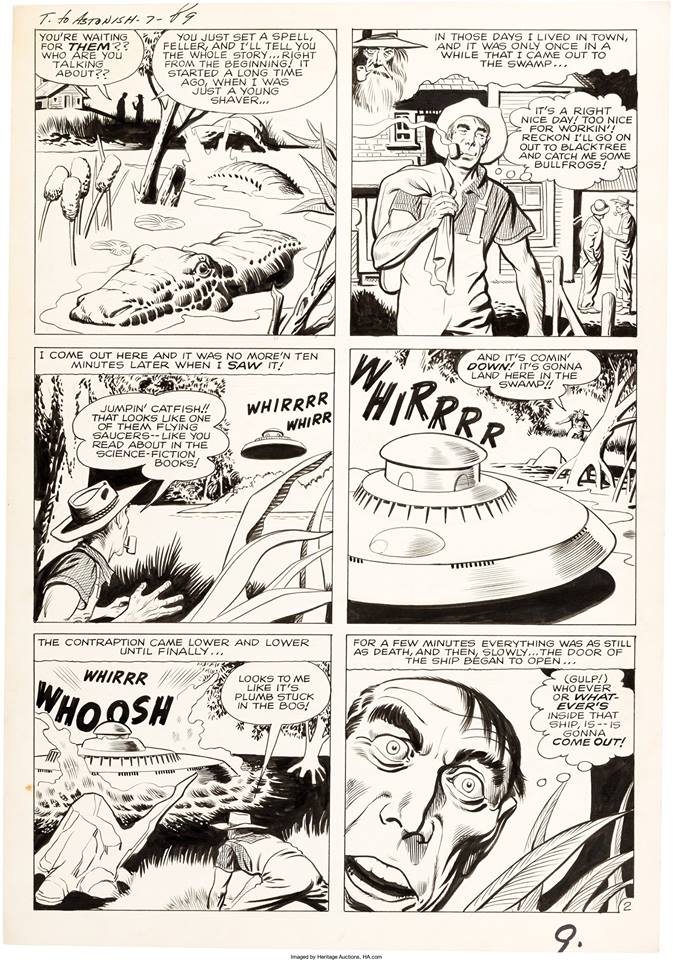
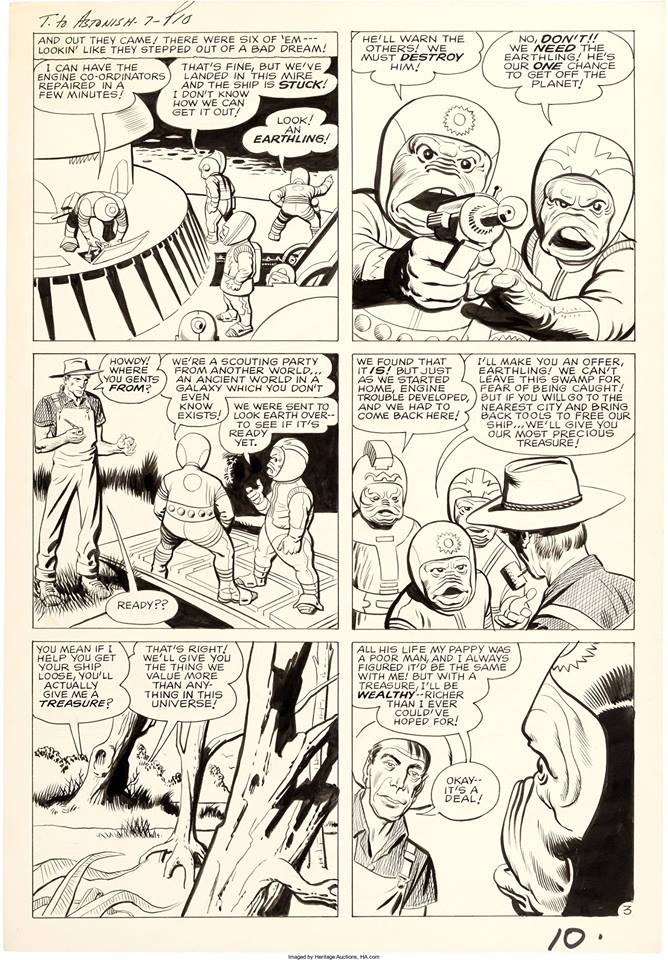
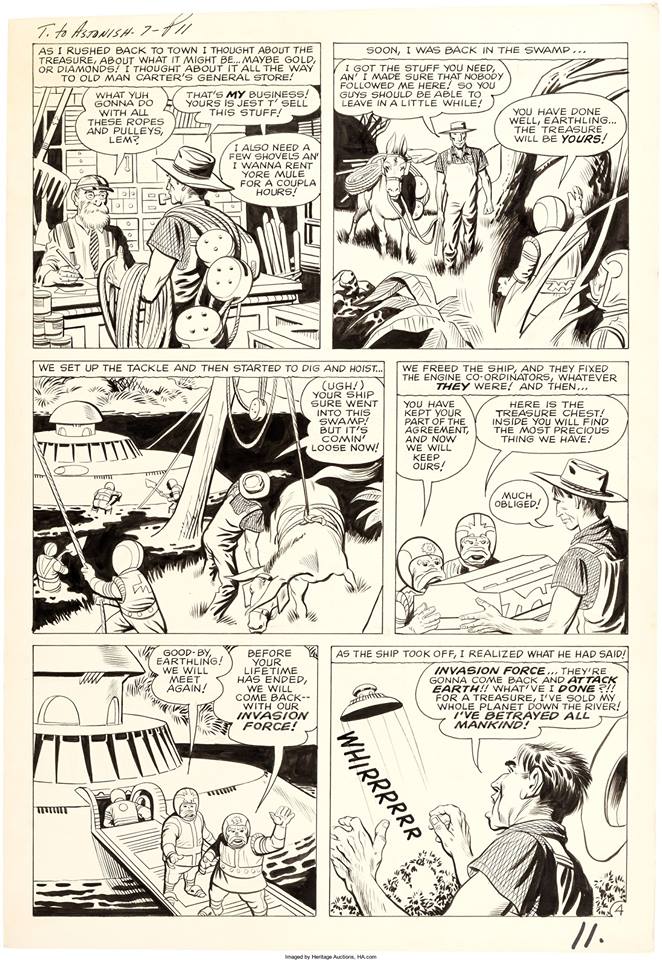
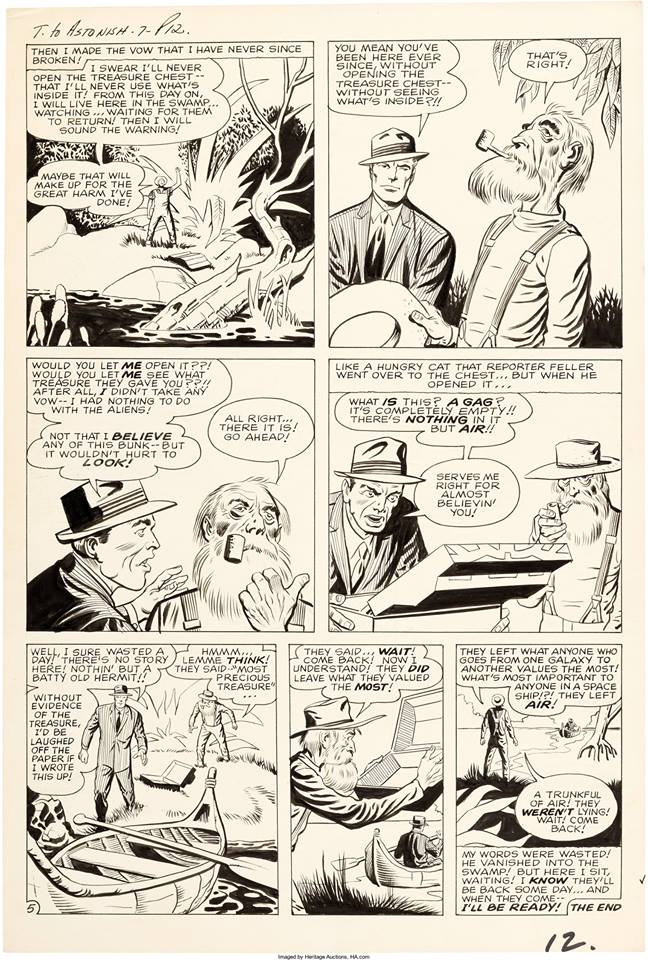 Newly emerged Kirby pages inked by Steve Ditko. "We Met In The Swamp" A complete story from TALES TO ASTONISH #8 (1960).
Typical low resolution Heritage scans but good enough to see Kirby's penciled lettering on every page.
Patrick Ford: One interesting thing about the vast majority of these early Silver Age pages is how free from editorial notes and changes they are. Lee certainly wasn't busy because he was hardly writing anything and had very few books to edit.
Aaron Noble: It seems like when the superhero books took off, that lit the only creative fire Lee ever had, an idea for a promotional editorial style, influenced perhaps by the jocular tone of EC comics, and soon Stan couldn't keep his hands off every page that Kirby and Ditko turned in.
Patrick Ford: And yet he allowed Gene Colan to do whatever Colan liked. Ultimately resulting in Colan having a great deal of difficulty pleasing (according to Jim Shooter) many of the writers at Marvel, supposedly ( I am 100% unfamiliar with Colan's work ) due to Colan's undisciplined approach to storytelling.
Patrick Ford: Putting Colan aside (because I know nothing about him) this suggests to me that Lee took issue with people who were not sufficiently supplicant. Or whose talents threatened Lee's fragile ego.
[continued: did Lee edit any of the dialogue?]
Chris Tolworthy
19 May 2017
Newly emerged Kirby pages inked by Steve Ditko. "We Met In The Swamp" A complete story from TALES TO ASTONISH #8 (1960).
Typical low resolution Heritage scans but good enough to see Kirby's penciled lettering on every page.
Patrick Ford: One interesting thing about the vast majority of these early Silver Age pages is how free from editorial notes and changes they are. Lee certainly wasn't busy because he was hardly writing anything and had very few books to edit.
Aaron Noble: It seems like when the superhero books took off, that lit the only creative fire Lee ever had, an idea for a promotional editorial style, influenced perhaps by the jocular tone of EC comics, and soon Stan couldn't keep his hands off every page that Kirby and Ditko turned in.
Patrick Ford: And yet he allowed Gene Colan to do whatever Colan liked. Ultimately resulting in Colan having a great deal of difficulty pleasing (according to Jim Shooter) many of the writers at Marvel, supposedly ( I am 100% unfamiliar with Colan's work ) due to Colan's undisciplined approach to storytelling.
Patrick Ford: Putting Colan aside (because I know nothing about him) this suggests to me that Lee took issue with people who were not sufficiently supplicant. Or whose talents threatened Lee's fragile ego.
[continued: did Lee edit any of the dialogue?]
Chris Tolworthy
19 May 2017
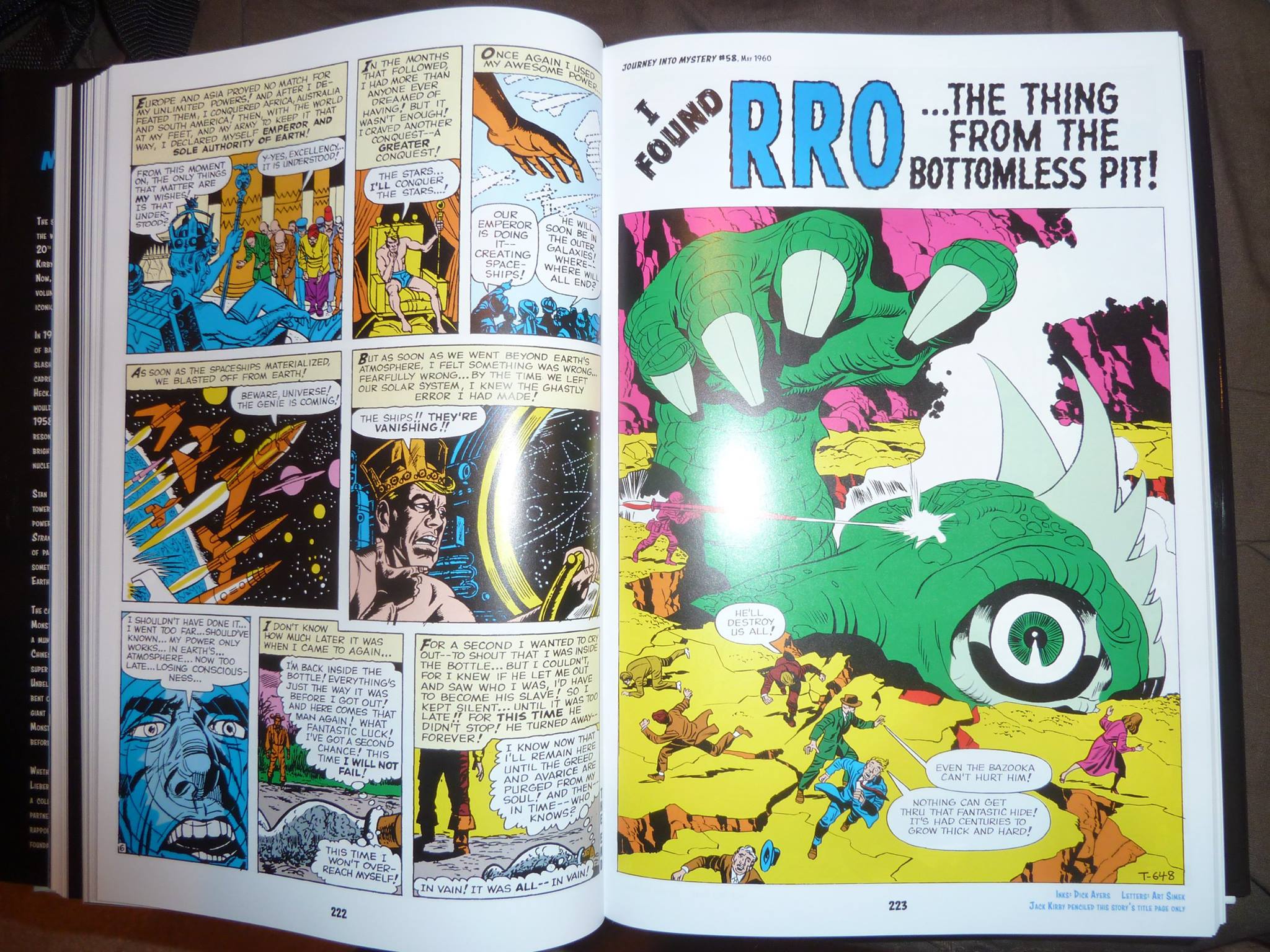 I'm interested in that last frame of the first story. Whenever I see so many words crammed into the final frame it makes me think the dialog writer was not communicating with the artist.
I'm assuming that this is a Kirby story (it's a Kirby book, and the royal court and bottle shape are like other Kirby images). Like most Kirby stories, it works even without the text. But it looks like whoever added the dialog felt the need to restate the obvious and spell everything out in detail. Even though the verbose description covers up the art. Is this evidence that after Kirby wrote the story, Lee re-wrote the dialog?
Patrick Ford: Chris, It's nice that all of Kirby's science fiction work from the '50s is now in print. It makes it possible to compare the very similar stories Kirby was doing for three different companies.
It is generally thought that Kirby wrote the short science fiction/fantasy stories for DC. It is almost universally accepted that Kirby wrote the science fiction stories for Harvey.
Patrick Ford: Let's have a look at a page from BLACK CAT MYSTIC #59.
We can see that, in the style of his romance work, Kirby's stories tend to be text heavy. Kirby also frequently retained the "confessional" style of story telling found in the romance stories. Titles like "I was the..." or "I found the..." or "I was a ..." are found in the stories of all three companies.
I'm interested in that last frame of the first story. Whenever I see so many words crammed into the final frame it makes me think the dialog writer was not communicating with the artist.
I'm assuming that this is a Kirby story (it's a Kirby book, and the royal court and bottle shape are like other Kirby images). Like most Kirby stories, it works even without the text. But it looks like whoever added the dialog felt the need to restate the obvious and spell everything out in detail. Even though the verbose description covers up the art. Is this evidence that after Kirby wrote the story, Lee re-wrote the dialog?
Patrick Ford: Chris, It's nice that all of Kirby's science fiction work from the '50s is now in print. It makes it possible to compare the very similar stories Kirby was doing for three different companies.
It is generally thought that Kirby wrote the short science fiction/fantasy stories for DC. It is almost universally accepted that Kirby wrote the science fiction stories for Harvey.
Patrick Ford: Let's have a look at a page from BLACK CAT MYSTIC #59.
We can see that, in the style of his romance work, Kirby's stories tend to be text heavy. Kirby also frequently retained the "confessional" style of story telling found in the romance stories. Titles like "I was the..." or "I found the..." or "I was a ..." are found in the stories of all three companies.
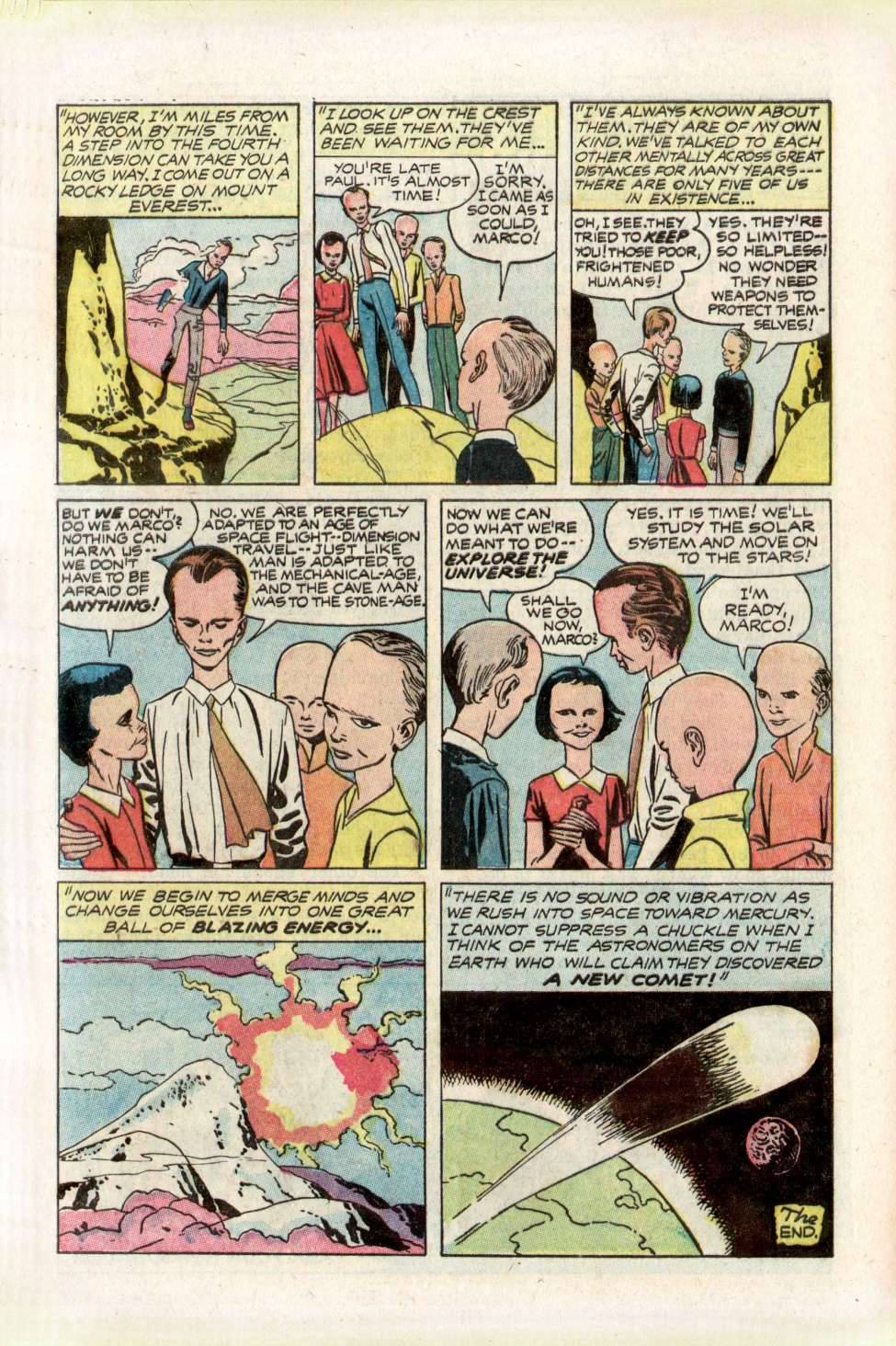 Aaron Noble: To me the caption in the final panel of the OP sounds very much like Kirby wrote it, and the thought balloons very much like someone else.
Patrick Ford: Compare "I found Roo" at Marvel to what Kirby was doing for DC at basically the exact same time.
Aaron Noble: To me the caption in the final panel of the OP sounds very much like Kirby wrote it, and the thought balloons very much like someone else.
Patrick Ford: Compare "I found Roo" at Marvel to what Kirby was doing for DC at basically the exact same time.
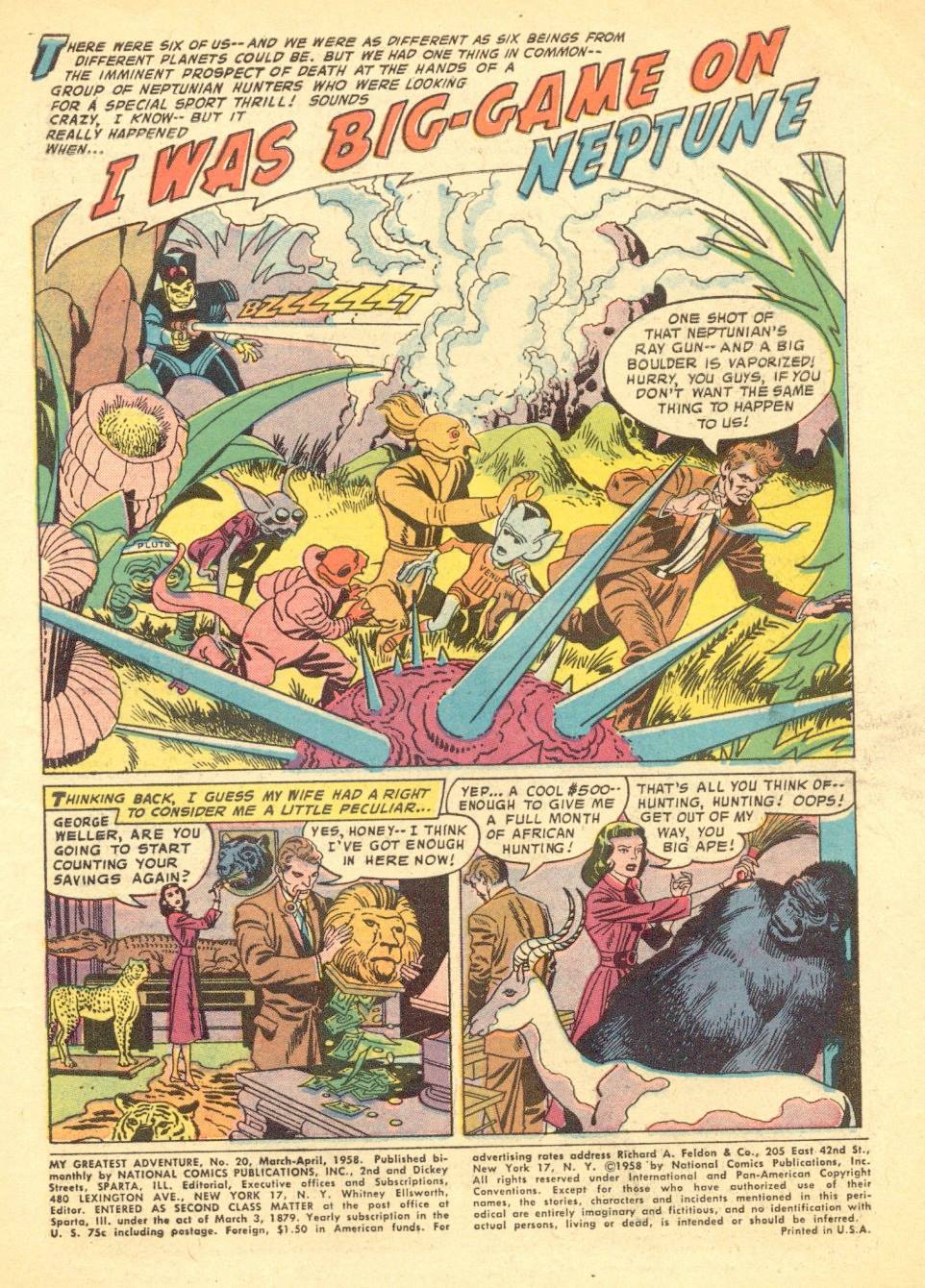 Patrick Ford:
Patrick Ford:
 Patrick Ford:
Patrick Ford:
 Patrick Ford:
Patrick Ford:
 Patrick Ford:
Patrick Ford:
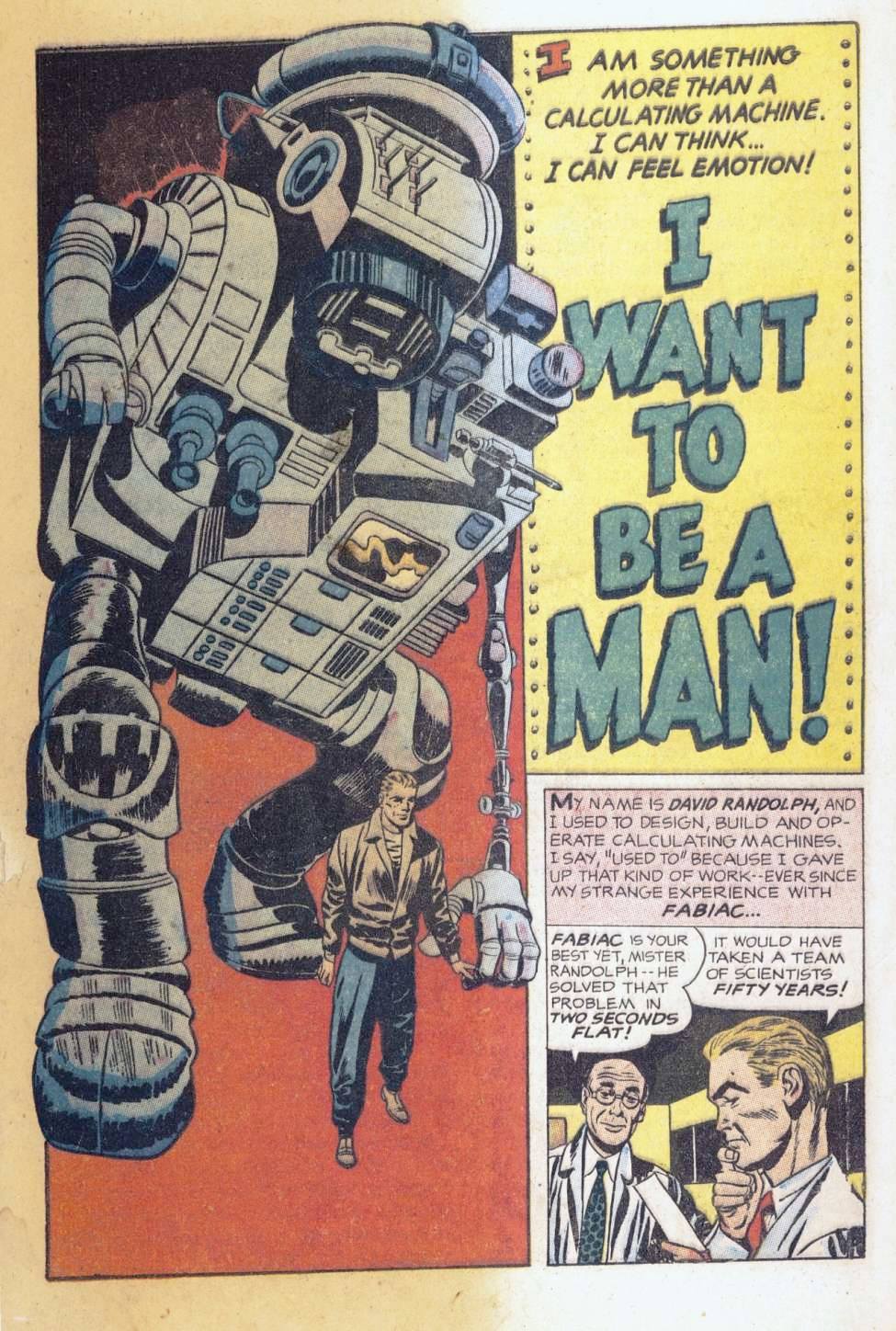 Patrick Ford:
Patrick Ford:
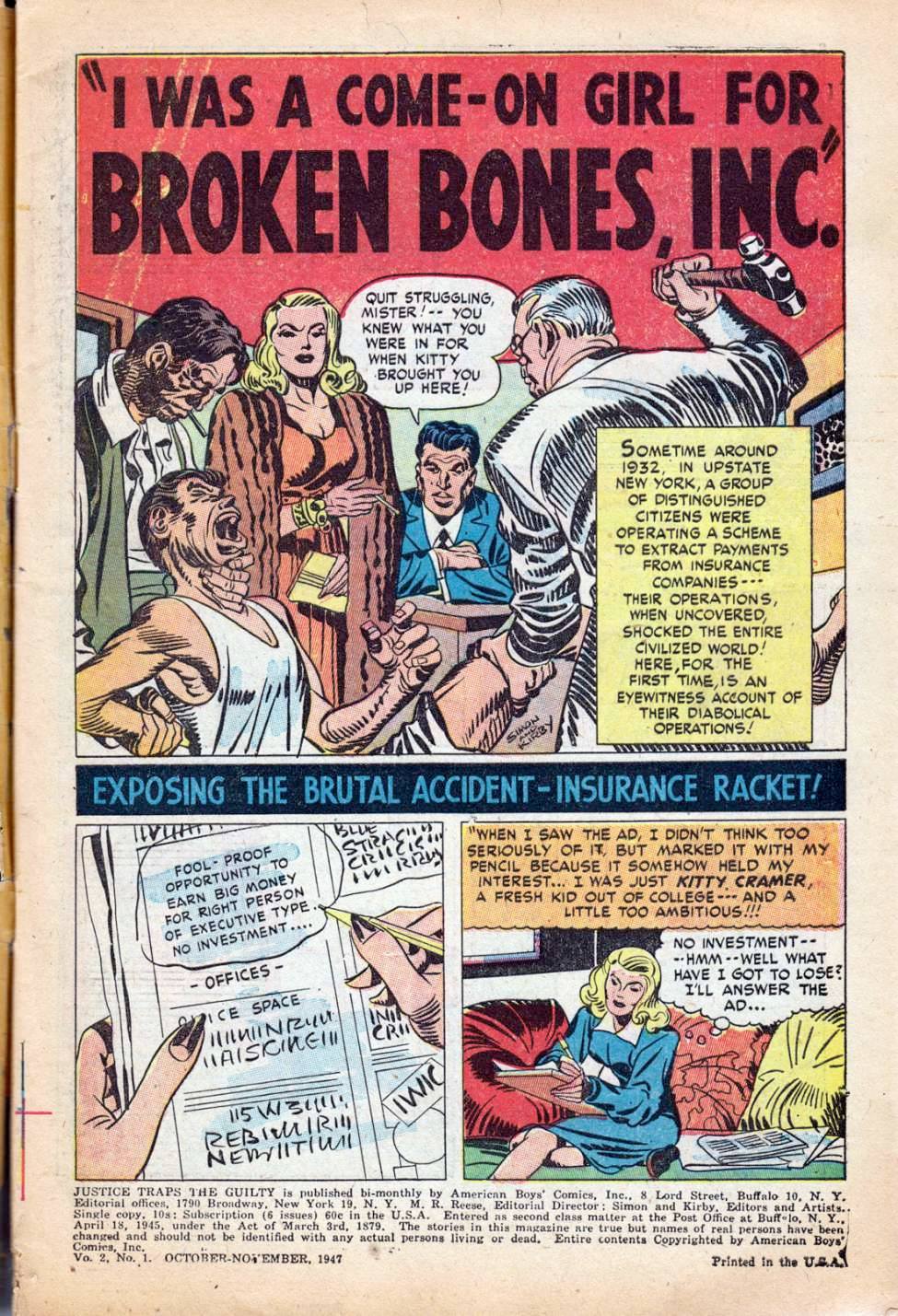 Aaron Noble: Was this a Kirby tick or was everybody doing the "I..." thing then? I seem to recall Men's Adventure mags of the day doing a lot of "I swam with the barracuda-woman" type of things.
Patrick Ford: It was definitely not unique to Kirby.
Patrick Ford: The giant robot wanting to be a man isn't unique to Kirby. However Kirby did more than less the same basic story for DC, Harvey and Marvel all within a year or so.
I'm not big on claiming that Kirby invented things. To me that isn't the key. It's the gigantic mountain of forensic evidence which adds up. The more you look at it the more there is. And as we know Lee pretty much did not write science fiction or fantasy prior to 1962.
Patrick Ford:
Aaron Noble: Was this a Kirby tick or was everybody doing the "I..." thing then? I seem to recall Men's Adventure mags of the day doing a lot of "I swam with the barracuda-woman" type of things.
Patrick Ford: It was definitely not unique to Kirby.
Patrick Ford: The giant robot wanting to be a man isn't unique to Kirby. However Kirby did more than less the same basic story for DC, Harvey and Marvel all within a year or so.
I'm not big on claiming that Kirby invented things. To me that isn't the key. It's the gigantic mountain of forensic evidence which adds up. The more you look at it the more there is. And as we know Lee pretty much did not write science fiction or fantasy prior to 1962.
Patrick Ford:
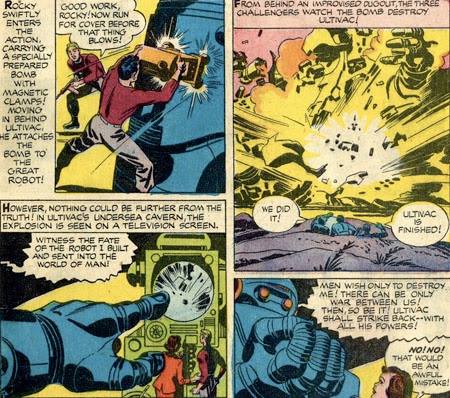 Patrick Ford:
Patrick Ford:
 Patrick Ford:
Patrick Ford:
 Patrick Ford:
Patrick Ford:
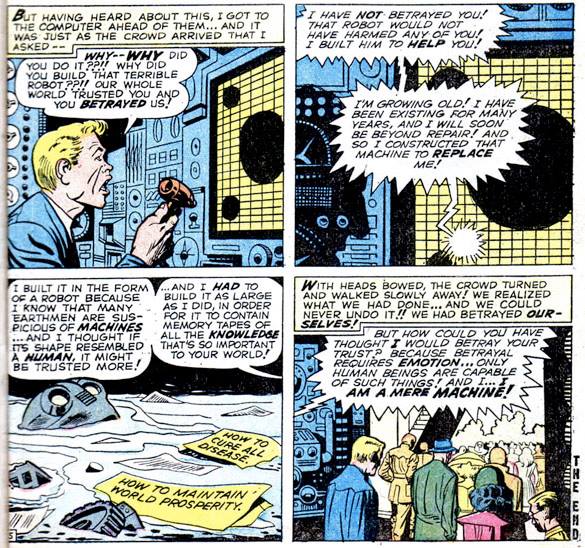 Patrick Ford: Kirby for Harvey on left. Kirby for Marvel on right.
Patrick Ford: Kirby for Harvey on left. Kirby for Marvel on right.
 Chris Tolworthy: Thanks. Then it's clear that a lot of text does not mean non-Kirby. But I still wonder about that last panel. All the examples here are well designed: the art may be small, but it's not squashed or cluttered or cut off. That last panel to me just looks different, like somebody ran out of space and suddenly didn't trust people to follow the art
I'm not suggesting that Kirby didn't write the story. But editors do exist and they sometimes edit text. For better or (usually in Kirby's case) for worse
Or maybe it was normal for final panels in the 1950s to look cramped to modern eyes? I recall posting last year about my surprise when reading old EC comics, how they seemed to end very abruptly. Maybe adding a wall of text in the last frame was just a way to make sure that even the slowest reader didn't leave confused, much like the habit in some old TV cop shows to explain what happened at the end, even though we should have guessed by then?
Just wondering I am certainly no expert on the era, so I am glad I can pick your brains!
Patrick Ford: It is somewhat reminiscent of the panel in the X-MEN where Magneto's upper body is covered by a balloon. What makes the X-Men panel so egregious is it's Magneto who is speaking.
At least in this case the speaker is inside the bottle.
Aaron Noble: I feel quite sure the balloons are not Kirby. The stupid moral lesson and whinging tone of "vain... all in vain..." are positively Lee-esque. It could be a scene from the original Silver Surfer run.
Patrick Ford: It's certainly likely Lee rewrote scripts from time to time. The original art pages from this period are remarkably free from indications of editorial changes, but there are not that many pages which I have seen. Also the pages at Heritage are hard to go by since the scans are not of high quality.
Chris Tolworthy: Thanks. Then it's clear that a lot of text does not mean non-Kirby. But I still wonder about that last panel. All the examples here are well designed: the art may be small, but it's not squashed or cluttered or cut off. That last panel to me just looks different, like somebody ran out of space and suddenly didn't trust people to follow the art
I'm not suggesting that Kirby didn't write the story. But editors do exist and they sometimes edit text. For better or (usually in Kirby's case) for worse
Or maybe it was normal for final panels in the 1950s to look cramped to modern eyes? I recall posting last year about my surprise when reading old EC comics, how they seemed to end very abruptly. Maybe adding a wall of text in the last frame was just a way to make sure that even the slowest reader didn't leave confused, much like the habit in some old TV cop shows to explain what happened at the end, even though we should have guessed by then?
Just wondering I am certainly no expert on the era, so I am glad I can pick your brains!
Patrick Ford: It is somewhat reminiscent of the panel in the X-MEN where Magneto's upper body is covered by a balloon. What makes the X-Men panel so egregious is it's Magneto who is speaking.
At least in this case the speaker is inside the bottle.
Aaron Noble: I feel quite sure the balloons are not Kirby. The stupid moral lesson and whinging tone of "vain... all in vain..." are positively Lee-esque. It could be a scene from the original Silver Surfer run.
Patrick Ford: It's certainly likely Lee rewrote scripts from time to time. The original art pages from this period are remarkably free from indications of editorial changes, but there are not that many pages which I have seen. Also the pages at Heritage are hard to go by since the scans are not of high quality.
home




 Newly emerged Kirby pages inked by Steve Ditko. "We Met In The Swamp" A complete story from TALES TO ASTONISH #8 (1960).
Typical low resolution Heritage scans but good enough to see Kirby's penciled lettering on every page.
Patrick Ford: One interesting thing about the vast majority of these early Silver Age pages is how free from editorial notes and changes they are. Lee certainly wasn't busy because he was hardly writing anything and had very few books to edit.
Aaron Noble: It seems like when the superhero books took off, that lit the only creative fire Lee ever had, an idea for a promotional editorial style, influenced perhaps by the jocular tone of EC comics, and soon Stan couldn't keep his hands off every page that Kirby and Ditko turned in.
Patrick Ford: And yet he allowed Gene Colan to do whatever Colan liked. Ultimately resulting in Colan having a great deal of difficulty pleasing (according to Jim Shooter) many of the writers at Marvel, supposedly ( I am 100% unfamiliar with Colan's work ) due to Colan's undisciplined approach to storytelling.
Patrick Ford: Putting Colan aside (because I know nothing about him) this suggests to me that Lee took issue with people who were not sufficiently supplicant. Or whose talents threatened Lee's fragile ego.
[continued: did Lee edit any of the dialogue?]
Chris Tolworthy
19 May 2017
Newly emerged Kirby pages inked by Steve Ditko. "We Met In The Swamp" A complete story from TALES TO ASTONISH #8 (1960).
Typical low resolution Heritage scans but good enough to see Kirby's penciled lettering on every page.
Patrick Ford: One interesting thing about the vast majority of these early Silver Age pages is how free from editorial notes and changes they are. Lee certainly wasn't busy because he was hardly writing anything and had very few books to edit.
Aaron Noble: It seems like when the superhero books took off, that lit the only creative fire Lee ever had, an idea for a promotional editorial style, influenced perhaps by the jocular tone of EC comics, and soon Stan couldn't keep his hands off every page that Kirby and Ditko turned in.
Patrick Ford: And yet he allowed Gene Colan to do whatever Colan liked. Ultimately resulting in Colan having a great deal of difficulty pleasing (according to Jim Shooter) many of the writers at Marvel, supposedly ( I am 100% unfamiliar with Colan's work ) due to Colan's undisciplined approach to storytelling.
Patrick Ford: Putting Colan aside (because I know nothing about him) this suggests to me that Lee took issue with people who were not sufficiently supplicant. Or whose talents threatened Lee's fragile ego.
[continued: did Lee edit any of the dialogue?]
Chris Tolworthy
19 May 2017  I'm interested in that last frame of the first story. Whenever I see so many words crammed into the final frame it makes me think the dialog writer was not communicating with the artist.
I'm assuming that this is a Kirby story (it's a Kirby book, and the royal court and bottle shape are like other Kirby images). Like most Kirby stories, it works even without the text. But it looks like whoever added the dialog felt the need to restate the obvious and spell everything out in detail. Even though the verbose description covers up the art. Is this evidence that after Kirby wrote the story, Lee re-wrote the dialog?
Patrick Ford: Chris, It's nice that all of Kirby's science fiction work from the '50s is now in print. It makes it possible to compare the very similar stories Kirby was doing for three different companies.
It is generally thought that Kirby wrote the short science fiction/fantasy stories for DC. It is almost universally accepted that Kirby wrote the science fiction stories for Harvey.
Patrick Ford: Let's have a look at a page from BLACK CAT MYSTIC #59.
We can see that, in the style of his romance work, Kirby's stories tend to be text heavy. Kirby also frequently retained the "confessional" style of story telling found in the romance stories. Titles like "I was the..." or "I found the..." or "I was a ..." are found in the stories of all three companies.
I'm interested in that last frame of the first story. Whenever I see so many words crammed into the final frame it makes me think the dialog writer was not communicating with the artist.
I'm assuming that this is a Kirby story (it's a Kirby book, and the royal court and bottle shape are like other Kirby images). Like most Kirby stories, it works even without the text. But it looks like whoever added the dialog felt the need to restate the obvious and spell everything out in detail. Even though the verbose description covers up the art. Is this evidence that after Kirby wrote the story, Lee re-wrote the dialog?
Patrick Ford: Chris, It's nice that all of Kirby's science fiction work from the '50s is now in print. It makes it possible to compare the very similar stories Kirby was doing for three different companies.
It is generally thought that Kirby wrote the short science fiction/fantasy stories for DC. It is almost universally accepted that Kirby wrote the science fiction stories for Harvey.
Patrick Ford: Let's have a look at a page from BLACK CAT MYSTIC #59.
We can see that, in the style of his romance work, Kirby's stories tend to be text heavy. Kirby also frequently retained the "confessional" style of story telling found in the romance stories. Titles like "I was the..." or "I found the..." or "I was a ..." are found in the stories of all three companies.  Aaron Noble: To me the caption in the final panel of the OP sounds very much like Kirby wrote it, and the thought balloons very much like someone else.
Patrick Ford: Compare "I found Roo" at Marvel to what Kirby was doing for DC at basically the exact same time.
Aaron Noble: To me the caption in the final panel of the OP sounds very much like Kirby wrote it, and the thought balloons very much like someone else.
Patrick Ford: Compare "I found Roo" at Marvel to what Kirby was doing for DC at basically the exact same time.  Patrick Ford:
Patrick Ford:  Patrick Ford:
Patrick Ford:  Patrick Ford:
Patrick Ford:  Patrick Ford:
Patrick Ford:  Patrick Ford:
Patrick Ford:  Aaron Noble: Was this a Kirby tick or was everybody doing the "I..." thing then? I seem to recall Men's Adventure mags of the day doing a lot of "I swam with the barracuda-woman" type of things.
Patrick Ford: It was definitely not unique to Kirby.
Patrick Ford: The giant robot wanting to be a man isn't unique to Kirby. However Kirby did more than less the same basic story for DC, Harvey and Marvel all within a year or so.
I'm not big on claiming that Kirby invented things. To me that isn't the key. It's the gigantic mountain of forensic evidence which adds up. The more you look at it the more there is. And as we know Lee pretty much did not write science fiction or fantasy prior to 1962.
Patrick Ford:
Aaron Noble: Was this a Kirby tick or was everybody doing the "I..." thing then? I seem to recall Men's Adventure mags of the day doing a lot of "I swam with the barracuda-woman" type of things.
Patrick Ford: It was definitely not unique to Kirby.
Patrick Ford: The giant robot wanting to be a man isn't unique to Kirby. However Kirby did more than less the same basic story for DC, Harvey and Marvel all within a year or so.
I'm not big on claiming that Kirby invented things. To me that isn't the key. It's the gigantic mountain of forensic evidence which adds up. The more you look at it the more there is. And as we know Lee pretty much did not write science fiction or fantasy prior to 1962.
Patrick Ford:  Patrick Ford:
Patrick Ford:  Patrick Ford:
Patrick Ford:  Patrick Ford:
Patrick Ford:  Patrick Ford: Kirby for Harvey on left. Kirby for Marvel on right.
Patrick Ford: Kirby for Harvey on left. Kirby for Marvel on right.  Chris Tolworthy: Thanks. Then it's clear that a lot of text does not mean non-Kirby. But I still wonder about that last panel. All the examples here are well designed: the art may be small, but it's not squashed or cluttered or cut off. That last panel to me just looks different, like somebody ran out of space and suddenly didn't trust people to follow the art
I'm not suggesting that Kirby didn't write the story. But editors do exist and they sometimes edit text. For better or (usually in Kirby's case) for worse
Or maybe it was normal for final panels in the 1950s to look cramped to modern eyes? I recall posting last year about my surprise when reading old EC comics, how they seemed to end very abruptly. Maybe adding a wall of text in the last frame was just a way to make sure that even the slowest reader didn't leave confused, much like the habit in some old TV cop shows to explain what happened at the end, even though we should have guessed by then?
Just wondering I am certainly no expert on the era, so I am glad I can pick your brains!
Patrick Ford: It is somewhat reminiscent of the panel in the X-MEN where Magneto's upper body is covered by a balloon. What makes the X-Men panel so egregious is it's Magneto who is speaking.
At least in this case the speaker is inside the bottle.
Aaron Noble: I feel quite sure the balloons are not Kirby. The stupid moral lesson and whinging tone of "vain... all in vain..." are positively Lee-esque. It could be a scene from the original Silver Surfer run.
Patrick Ford: It's certainly likely Lee rewrote scripts from time to time. The original art pages from this period are remarkably free from indications of editorial changes, but there are not that many pages which I have seen. Also the pages at Heritage are hard to go by since the scans are not of high quality.
Chris Tolworthy: Thanks. Then it's clear that a lot of text does not mean non-Kirby. But I still wonder about that last panel. All the examples here are well designed: the art may be small, but it's not squashed or cluttered or cut off. That last panel to me just looks different, like somebody ran out of space and suddenly didn't trust people to follow the art
I'm not suggesting that Kirby didn't write the story. But editors do exist and they sometimes edit text. For better or (usually in Kirby's case) for worse
Or maybe it was normal for final panels in the 1950s to look cramped to modern eyes? I recall posting last year about my surprise when reading old EC comics, how they seemed to end very abruptly. Maybe adding a wall of text in the last frame was just a way to make sure that even the slowest reader didn't leave confused, much like the habit in some old TV cop shows to explain what happened at the end, even though we should have guessed by then?
Just wondering I am certainly no expert on the era, so I am glad I can pick your brains!
Patrick Ford: It is somewhat reminiscent of the panel in the X-MEN where Magneto's upper body is covered by a balloon. What makes the X-Men panel so egregious is it's Magneto who is speaking.
At least in this case the speaker is inside the bottle.
Aaron Noble: I feel quite sure the balloons are not Kirby. The stupid moral lesson and whinging tone of "vain... all in vain..." are positively Lee-esque. It could be a scene from the original Silver Surfer run.
Patrick Ford: It's certainly likely Lee rewrote scripts from time to time. The original art pages from this period are remarkably free from indications of editorial changes, but there are not that many pages which I have seen. Also the pages at Heritage are hard to go by since the scans are not of high quality.